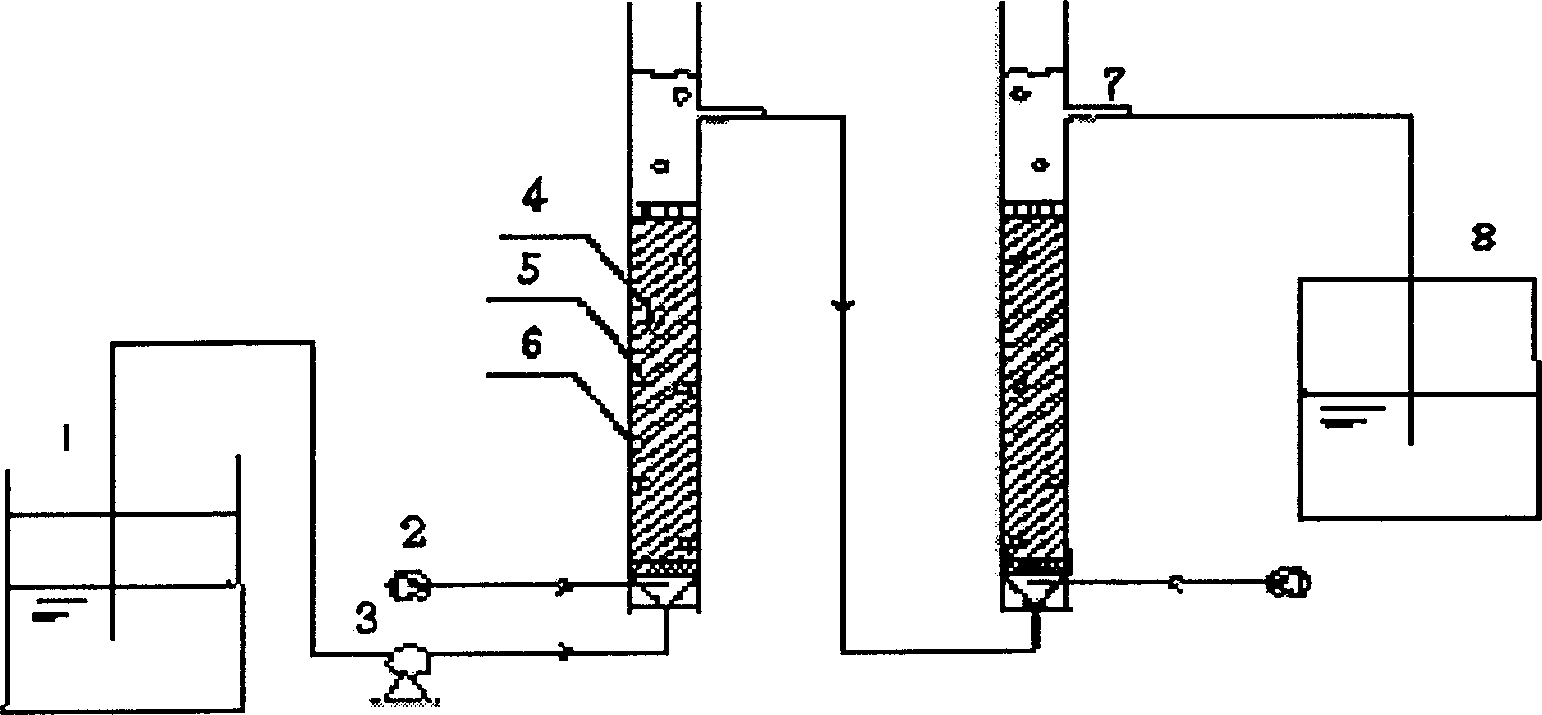Method and apparatus for immobilizing cells to treat wastewater
A technology for treating wastewater and wastewater, which is applied in the fields of chemical instruments and methods, biological water/sewage treatment, etc., which are fixed on or in biological cells, and can solve the problems of high organic solvent content, difficult selection of flora, and high operating costs. To achieve the effect of improving tolerance and degradation ability, increasing oxidation reaction rate, and increasing contact area
- Summary
- Abstract
- Description
- Claims
- Application Information
AI Technical Summary
Problems solved by technology
Method used
Image
Examples
Embodiment 1
[0037] The method of increasing the content of plasticizer production wastewater in the culture medium is used for domestication, and the tolerance and degradation ability of the white rot fungus Versicolor versicolor (Polyporus versicolor NG04010) are gradually improved. The white-rot fungus Versicolor Versicolor Versicolor NG04010 was cultured for 7 days to collect mycelia. The culture method was a conventional method, and the culture medium was mashed potatoes mixed with wheat bran.
[0038] Pseudomonas fluorescens ATCC11172 (Pseudomonas fluorescens ATCC11172) was cultivated for 3 days, and the sludge was collected by centrifugation. The culture method was a conventional method, and the culture medium was malic acid 10g / L, (NH 4 ) 2 SO 4 2g / L and yeast extract 1g / L.
[0039] Mix the above-mentioned mycelia and fungus slime collected in a ratio of 5:1 to obtain a mixture, and then stir the mixture into about 50-100 times (weight ratio to the mixture) of the discarded Rhiz...
Embodiment 2
[0042] The method of increasing the content of landfill leachate in the culture medium is used for domestication, and the tolerance and degradation ability of the white rot fungus Pleurotus pulmonarius NG 0412 are gradually improved. The domesticated white rot fungus Pleurotus pulmonarius NG 0412 was cultured in a solid state for 7 days to collect mycelium. The culture method was a conventional method, and the culture medium was mashed potatoes mixed with wheat bran.
[0043] Nitrosomonas (Nitrosomonas europaea IFO14298) was cultivated for 7 days, and the sludge was collected by centrifugation. The cultivation method was a conventional method, and the culture medium contained 0.3g of NaCl and MgSO in every liter of water. 4 ·7H 2 O 0.14g, FeSO 4 ·7H 2 O 0.03g, (NH 4 ) 2 SO 4 0.6g, KH 2 PO 4 2g.
[0044] Mix the above-mentioned mycelia and fungus slime collected in a ratio of 3:1 to obtain a mixture, and then mix the mixture into about 50-100 times (weight ratio to th...
Embodiment 3
[0047] The method of increasing the content of phenolic resin production wastewater in the culture medium is used for domestication, and the tolerance and degradation ability of the white rot fungus Phanerochaete Chrysosporium (Phanerochaete Chrysosporium ME-446) are gradually improved. White rot fungus (PChrysosporium ME-446) was cultured in solid state for 7 days to collect mycelium, the culture method was a conventional method, and the culture medium was mashed potatoes mixed with wheat bran.
[0048] Rhodococcus erythropolis (Rhodococcus erythropolis NG0402) was cultivated for 3 days, and the sludge was collected by centrifugation. The cultivation method was a conventional method, and the culture medium was glucose 20g L -1 , protein building 20g·L -1 , yeast extract 10g·L -1 , K 2 HPO 4 2g·L -1 , MgSO 4 ·7H 2 O 0.5g·L -1 , pH7.0-7.2.
[0049] Mix the above-mentioned mycelia and fungus slime collected in a ratio of 7:1 to obtain a mixture, and then mix the mixture...
PUM
 Login to View More
Login to View More Abstract
Description
Claims
Application Information
 Login to View More
Login to View More - R&D
- Intellectual Property
- Life Sciences
- Materials
- Tech Scout
- Unparalleled Data Quality
- Higher Quality Content
- 60% Fewer Hallucinations
Browse by: Latest US Patents, China's latest patents, Technical Efficacy Thesaurus, Application Domain, Technology Topic, Popular Technical Reports.
© 2025 PatSnap. All rights reserved.Legal|Privacy policy|Modern Slavery Act Transparency Statement|Sitemap|About US| Contact US: help@patsnap.com



